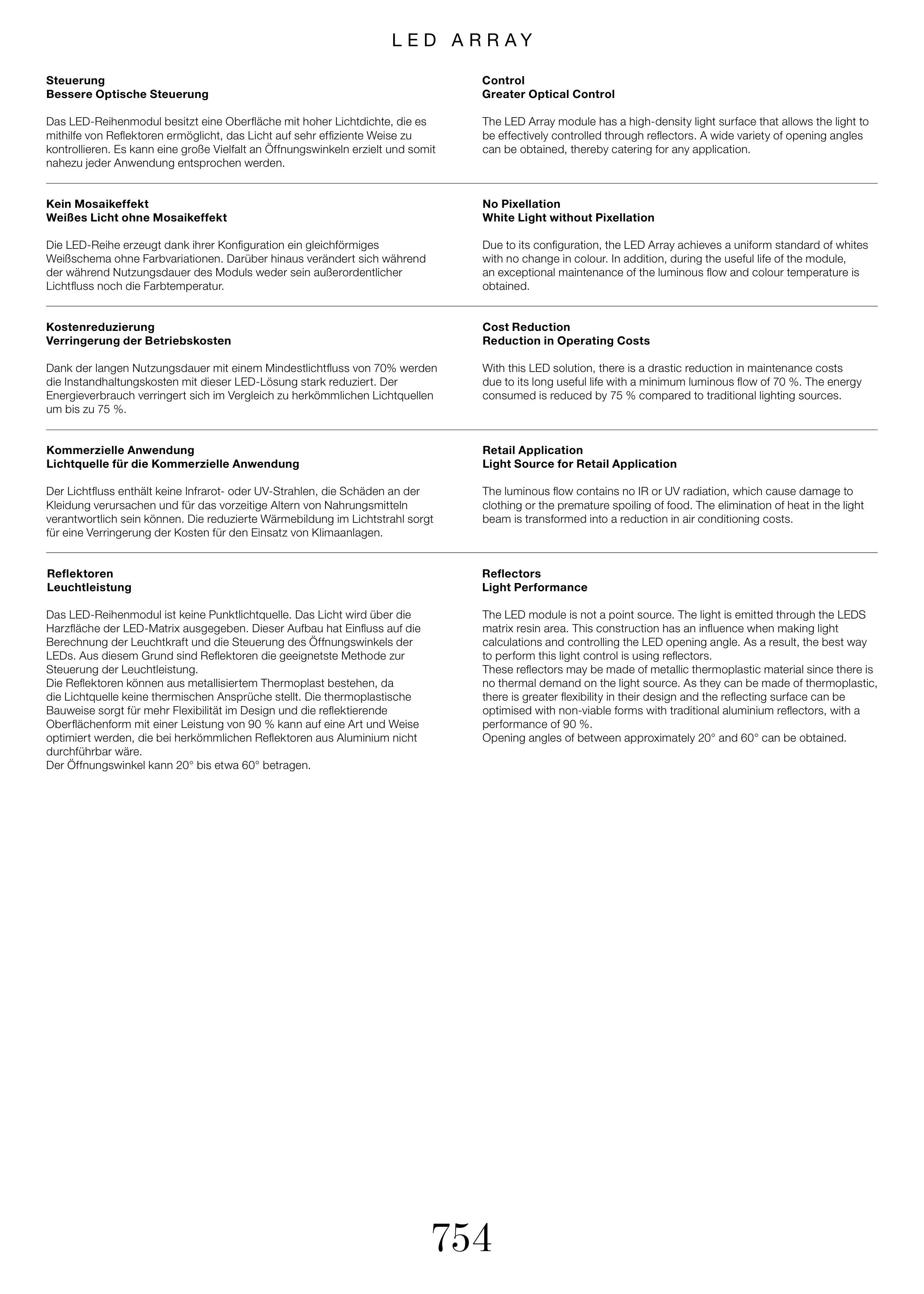754
L E D A R R A Y
Steuerung
Bessere Optische Steuerung
Das LED-Reihenmodul besitzt eine Oberfläche mit hoher Lichtdichte, die es
mithilfe von Reflektoren ermöglicht, das Licht auf sehr effiziente Weise zu
kontrollieren. Es kann eine große Vielfalt an Öffnungswinkeln erzielt und somit
nahezu jeder Anwendung entsprochen werden.
Die LED-Reihe erzeugt dank ihrer Konfiguration ein gleichförmiges
Weißschema ohne Farbvariationen. Darüber hinaus verändert sich während
der während Nutzungsdauer des Moduls weder sein außerordentlicher
Lichtfluss noch die Farbtemperatur.
Dank der langen Nutzungsdauer mit einem Mindestlichtfluss von 70% werden
die Instandhaltungskosten mit dieser LED-Lösung stark reduziert. Der
Energieverbrauch verringert sich im Vergleich zu herkömmlichen Lichtquellen
um bis zu 75 %.
Der Lichtfluss enthält keine Infrarot- oder UV-Strahlen, die Schäden an der
Kleidung verursachen und für das vorzeitige Altern von Nahrungsmitteln
verantwortlich sein können. Die reduzierte Wärmebildung im Lichtstrahl sorgt
für eine Verringerung der Kosten für den Einsatz von Klimaanlagen.
Das LED-Reihenmodul ist keine Punktlichtquelle. Das Licht wird über die
Harzfläche der LED-Matrix ausgegeben. Dieser Aufbau hat Einfluss auf die
Berechnung der Leuchtkraft und die Steuerung des Öffnungswinkels der
LEDs. Aus diesem Grund sind Reflektoren die geeignetste Methode zur
Steuerung der Leuchtleistung.
Die Reflektoren können aus metallisiertem Thermoplast bestehen, da
die Lichtquelle keine thermischen Ansprüche stellt. Die thermoplastische
Bauweise sorgt für mehr Flexibilität im Design und die reflektierende
Oberflächenform mit einer Leistung von 90 % kann auf eine Art und Weise
optimiert werden, die bei herkömmlichen Reflektoren aus Aluminium nicht
durchführbar wäre.
Der Öffnungswinkel kann 20° bis etwa 60° betragen.
Kein Mosaikeffekt
Weißes Licht ohne Mosaikeffekt
Kostenreduzierung
Verringerung der Betriebskosten
Kommerzielle Anwendung
Lichtquelle für die Kommerzielle Anwendung
Reflektoren
Leuchtleistung
Control
Greater Optical Control
The LED Array module has a high-density light surface that allows the light to
be effectively controlled through reflectors. A wide variety of opening angles
can be obtained, thereby catering for any application.
Due to its configuration, the LED Array achieves a uniform standard of whites
with no change in colour. In addition, during the useful life of the module,
an exceptional maintenance of the luminous flow and colour temperature is
obtained.
With this LED solution, there is a drastic reduction in maintenance costs
due to its long useful life with a minimum luminous flow of 70 %. The energy
consumed is reduced by 75 % compared to traditional lighting sources.
The luminous flow contains no IR or UV radiation, which cause damage to
clothing or the premature spoiling of food. The elimination of heat in the light
beam is transformed into a reduction in air conditioning costs.
The LED module is not a point source. The light is emitted through the LEDS
matrix resin area. This construction has an influence when making light
calculations and controlling the LED opening angle. As a result, the best way
to perform this light control is using reflectors.
These reflectors may be made of metallic thermoplastic material since there is
no thermal demand on the light source. As they can be made of thermoplastic,
there is greater flexibility in their design and the reflecting surface can be
optimised with non-viable forms with traditional aluminium reflectors, with a
performance of 90 %.
Opening angles of between approximately 20° and 60° can be obtained.
No Pixellation
White Light without Pixellation
Cost Reduction
Reduction in Operating Costs
Retail Application
Light Source for Retail Application
Reflectors
Light Performance


